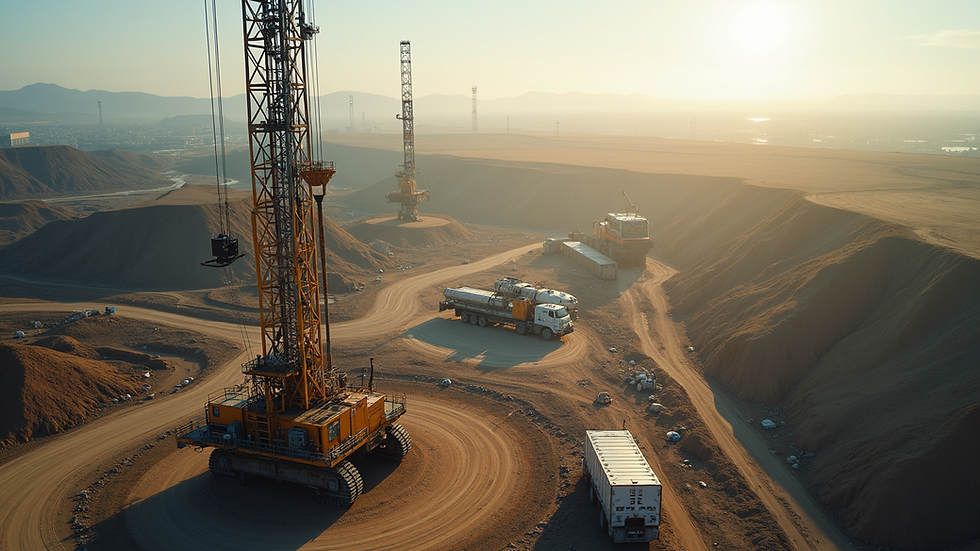Creative Thinking for Risk Management in the Oil & Gas Sector
- ardhy samjaya
- Jul 18
- 4 min read
In today's high-risk environments, traditional safety protocols often fall short. The Oil & Gas sector, characterized by its complexity and hazardous conditions, needs a new approach to risk management. Creative risk management strategies are becoming essential to enhance safety and streamline operations. This blog will explore why innovative thinking is key to risk mitigation, fostering a culture of safety, and developing effective risk management strategies.
The Need for Creativity in Risk Management
The Oil & Gas industry faces many challenges, such as extreme working conditions, fluctuating market demands, and the constant risk of accidents. Traditional methods typically rely on established protocols, which may not be adequate in unexpected situations. Creative thinking can bridge this gap.
Creative risk management means applying fresh ideas to identify, assess, and mitigate risks. For instance, a drilling company might use brainstorming sessions to find ways to improve emergency plans instead of just sticking to standard procedures. This encourages teams to think beyond the usual methods and discover solutions tailored to the unique challenges they face.
Rethinking Risk Assessment Strategies
To innovate in risk management, the first step is often to rethink traditional assessment strategies. Traditional risk assessments frequently rely on historical data and standard risk matrices. While these tools provide valuable insights, they can miss emerging risks and evolving industry trends.
Incorporating creative methodologies like scenario planning can help teams visualize multiple outcomes based on different contingency plans. For example, a company may run simulations to evaluate how their equipment would respond to various emergency situations. This flexible approach deepens understanding of potential risks, leading to better safety protocols.
Fostering a Culture of HSE Creativity
For creative risk management to thrive, the Oil & Gas industry must create a culture that welcomes new ideas and experimentation. Health, Safety, and Environment (HSE) officers have a crucial role in this transformation.
Encouraging team members to share ideas openly can spark innovative safety solutions. Research shows that companies with diverse teams are 35% more likely to outperform their competitors. Involving a range of employees in safety discussions can lead to fresh insights that drive safety planning beyond traditional boundaries.
Collaborative Problem-Solving in Risk Mitigation
Collaboration across disciplines adds another layer to creative risk management. Different experts—from geologists to engineers—bring unique perspectives to the table. For instance, if geologists and safety officers collaborate, they can identify geological hazards that might pose risks during drilling.
Using workshops or team-building exercises can bolster a sense of community and a shared purpose among employees. This teamwork allows teams to tackle problems from various angles, often resulting in innovative solutions that are both effective and practical.
Harnessing Technology and Data Analytics
Integrating technology into risk management is currently essential in the Oil & Gas sector. Tools such as data analytics, machine learning, and IoT devices offer valuable insights into operational risks.
For example, real-time data analytics can alert teams to potential hazards by processing large volumes of data instantly. This proactive approach not only improves situational awareness but also enables organizations to adopt creative strategies for handling unforeseen incidents. Statistics show that companies utilizing data analytics improve their risk identification efficiency by up to 50%.

Case Studies: Successful Applications of Creative Risk Management
Numerous case studies highlight the effectiveness of creative risk management in the Oil & Gas sector. One notable example is the use of virtual reality (VR) training simulations. These immersive experiences allow workers to navigate lifelike scenarios, providing them with hands-on experience without the dangers that come with real-life training.
Another successful application involves companies utilizing predictive analytics to foresee potential equipment failures. By examining historical data and identifying trends, teams not only prevent accidents but also fine-tune maintenance schedules. This approach can enhance overall safety and reduce downtime by 20%.
Continuous Improvement and Feedback Loops
Creative risk management is an ongoing journey rather than a one-time effort. Establishing feedback loops and mechanisms for continuous improvement ensures that risk management strategies adapt alongside the industry.
Regularly gathering feedback about safety protocols helps organizations refine their approaches. Whether through periodic safety audits or anonymous suggestion systems, creating open communication channels encourages a culture of HSE creativity and innovation.

The Path Ahead
Integrating creative thinking into risk management is essential for the Oil & Gas sector. By revamping traditional assessment methods, fostering a culture that values creativity, leveraging collaboration, utilizing technological advancements, and continuously improving strategies, industry professionals can enhance safety significantly.
As the landscape of Oil & Gas continues to grow and change, embracing creative risk management is not just beneficial—it is vital. Companies stand to gain immensely from innovative safety planning and strategies that mitigate risks. This approach not only protects personnel but also strengthens operational resilience.
By championing creativity in risk management practices, the Oil & Gas industry reaffirms its commitment to excellence and safety. As teams embark on this enriching journey, they are not only safeguarding their operations but also setting a benchmark for future practices in the industry.





